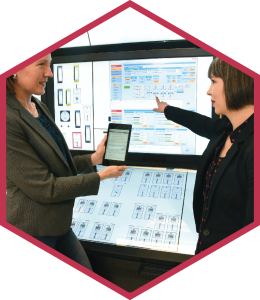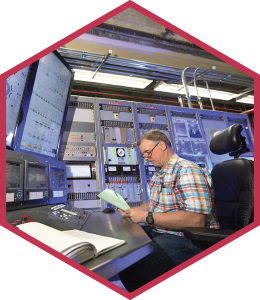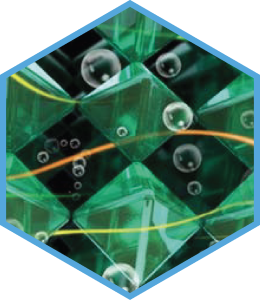IDAHO IMPACT
While INL is a national laboratory, it is also Idaho’s national laboratory. An important element of INL’s mission is ensuring support of the the local community and state at large through advocating and providing STEM resources for all students while also equipping local communities with expertise needed to help their communities thrive.

INL proudly accepted the Friend of the Community Award from Idaho’s Commission on Hispanic Affairs in September 2020. The award is given to an ally of the Latinx community. “We felt strongly that INL has been a big ally to our community for years,” Juan Saldaña, Community Resource Development Specialist, said. One of INL’s contributions includes participation and support of the Idaho Hispanic Youth Leadership Summit, a yearly event bringing Hispanic high schoolers from around the state to learn about leadership, college applications, and apply for scholarships.”

As Teton Valley, Idaho, pursues a community aquatic center, Idaho National Laboratory has lent its expertise in geothermal energy to find out whether access to hot water beneath the valley floor might have the potential to make such a center self-sustaining. Through the lab’s Technical Assistance Program (TAP), under which INL subject matter experts can be assigned to a company or project for 40 hours, Geothermal Program Manager Rob Podgorney used data from a decades-old abandoned exploration well to perform a geothermal assessment. If water from a test well to be drilled in 2021 confirms the study’s results, the community could have access to a resource that would allow the aquatics center to operate with few carbon emissions while paying for most, if not all, of the operating and utility costs. There might even be enough hot water to provide excess geothermal capacity to homes in the area and businesses downtown.

Failure may not be an option, but failure offers opportunities. In fact, failure is often one of the most valuable tools a science, technology, engineering and math (STEM) student or professional can draw on to eventually succeed. ‘Failing forward is what we want,’ says Alaysha Whitworth, STEM coordinator at Ammon’s White Pine Charter School. ‘It’s a challenge to teach kids that.’ With support from INL, Whitworth took 45 of her students to the Idaho Invention Convention Regional Competition, 24 of which won a place in the national competition. This was INL’s first year supporting the Invention Convention, supplying not only financial support but judges for the regional competition.
COVID-19 RESPONSE
Across the globe, 2020 was a year unlike any other due to the COVID-19 pandemic. INL saw the opportunity to increase its support of its local community while also using its employee’s knowledge to fight the novel virus.
The COVID-19 pandemic through many people for a loop, including parents who became teachers overnight. Enter INL’s K-12 Education Enrichment Program. INL’s K-12 team already had several resources available for parents, student, and educators, but quickly put together lesson plans specifically for remote learning. Lessons like how to make a balloon-powered recycled car or about the basics of biomass. Over 5,000 people visited the website, downloading content to support student learning.

INL has a long history of giving back to Idaho, and the COVID-19 pandemic was no exception. To support the community, Battelle Energy Alliance, who manages INL for the U.S. Department of Energy, launched the INL Cares initiative. The initiative invested $200,000 in the community through its threefold mission: economic development, health care education and food insecurity. As part of this program, INL donated $100,000 to 28 businesses, teamed up with Crush the Curve Idaho to sponsor a summer essay contest, and donated $60,000 to area food banks.

INL has a long history of giving back to Idaho, and the COVID-19 pandemic was no exception. To support the community, Battelle Energy Alliance, who manages INL for the U.S. Department of Energy, launched the INL Cares initiative. The initiative invested $200,000 in the community through its threefold mission: economic development, health care education and food insecurity. As part of this program, INL donated $100,000 to 28 businesses, teamed up with Crush the Curve Idaho to sponsor a summer essay contest, and donated $60,000 to area food banks.

NUCLEAR ENERGY ACCOMPLISHMENTS

INL researchers participated in the development of Alloy 617, the first material in 30 years to be entered into the American Society of Mechanical Engineers (ASME) Boiler and Pressure Vessel Code. ASMC Code was established in the early 20th century to enforce rigorous safety standards in the production of boilers and mechanical engineering materials. A combination of nickel, chromium, cobalt and molybdenum, Alloy 617 can be used in the new generation of advanced nuclear plants because it is suited to higher temperature operation.

Just as with the Mars Curiosity Rover in 2012, the Perseverance Rover that was launched from Cape Canaveral on July 30 took with it a Radioisotope Thermoelectric Generator (RTG) assembled and tested by INL’s Space Nuclear Power and Isotope Technologies Division. Since 2004, the group has delivered RTGs to NASA, powering the Mars rovers and Pluto New Horizons, launched in 2006 and now more than 4.1 billion miles from Earth.

The Light Water Reactor Sustainability (LWRS) program received two commercialization grants from DOE, both aimed at addressing concerns with legacy technology in nuclear plants. Each incorporate image processing, machine learning, and advanced control methods, enabling drones to self-navigate in indoor environments such as those found at nuclear plants and inspect hard-to-reach locations. Likewise, digitizing data collection from analog gauges saves money by eliminating two rounds of manual inspection by operators.

One of four research and test reactors located at INL, the Advanced Test Reactor Critical facility directly supports the operation of INL’s 250-megawatt Advanced Test Reactor (ATR). ATRC recently underwent a 21-month upgrade of its digital instrumentation and control systems to ensure it can continue to support ATR for several more decades. The improved reliability has led the ATRC team to begin discussions with the National University Consortium and the Center for Advanced Energy Studies on the possibility of performing university laboratory experiments and classes using ATRC.

New software from INL improves plant control room operator efficiency, lowering associated costs. The software tools also make it easier for staff to do their jobs. The software decision tool guides operators through the complex task of deciding what steps to take next. Before, staff had to consult checklists and static documents. Now, the software shows operators dynamic content that applies to the current situation.
ENERGY INNOVATION ACCOMPLISHMENTS
Scientists from Idaho National Laboratory and University of California San Diego examining the first moments of battery recharging at the atomic level unexpectedly encountered a material that could open the door to better batteries and faster catalysts. While investigating the earliest stages of lithium recharging at the atomic level, they learned that slow, low-energy charging caused lithium atoms to deposit on electrodes in a disorganized way that improves charging behavior. This noncrystalline “glassy” lithium was something that had never been observed before. Creating such amorphous metals has traditionally been difficult. The findings, published in Nature Materials, suggest fine-tuning of recharging approaches may both boost battery life and produce glassy metals for other applications.

As California coped with wildfire-caused power outages and rolling blackouts, a tiny Native American tribe in the northernmost part of the state demonstrated how microgrids might offer a solution. In consultation with INL, the Blue Lake Rancheria tribe has built a network of solar panels, storage batteries, fuel cells and diesel generators on its 100 acres of trust lands in Humboldt County. The microgrid can operate as part of a broader utility network or completely on its own. In October 2019, when Pacific Gas & Electric cut power to more than 2 million people across Northern California, the tribe made hotel guest rooms available to eight critically ill patients from the county’s Health and Human Services Department.

Idaho National Laboratory is assisting three investor-owned utilities demonstrate technology to make hydrogen from water on an industrial scale using heat from nuclear power plants. The Energy Department’s INL-based Light Water Reactor Sustainability program is helping Ohio-based FirstEnergy Solutions, Xcel Energy of Minneapolis, and Arizona Public Service (APS) roll out projects over the next few years that will generate hydrogen with no carbon emissions for a world where demand is increasing exponentially for use in transportation, industry and energy storage.

Hydrogen has long been recognized as an energy storage medium, but the challenge has always been how to efficiently recover excess electricity when it’s needed. Idaho National Laboratory researchers have helped answer that question by developing a new electrode material called perovskite, which conducts electrons, oxygen ions and protons. In practical terms, the triple-conducting electrode means the reaction happens faster and more efficiently, so the operating temperature can be reduced and no extra hydrogen needs to be consumed.

As part of INL’s 70th anniversary celebration, researchers performed tests on a New Flyer Xcelsior, the company’s 60-foot transit bus, using a 350-kilowatt high-power charging station at the Electric Vehicle Infrastructure Laboratory. Researchers conducted a number of tests to quantify the performance of both the bus and the charger. The New Flyer bus is the first of its kind and traveled to INL under its own power. New Flyer and its subsidiary, Motor Coach Industries (MCI), have a long history with INL developing alternative transportation strategies for the laboratory’s buses.

NATIONAL SECURITY ACCOMPLISHMENTS

In November, the U.S. Department of Energy (DOE) established a $111 million public-private partnership aimed at securing U.S. manufacturing facilities from cyberthreats. The Cybersecurity Manufacturing Innovation Institute (CyManII) is led by the University of Texas San Antonio and features a consortium of 59 institutions, including Idaho National Laboratory (INL), who are working together to develop secure, energy-efficient approaches that will sustain the nation’s global leadership in manufacturing competitiveness.

Idaho National Laboratory is partnering with Montana State University in a new $3.1 million cybersecurity research project funded by the U.S. Department of Homeland Security. The three-year project will focus on developing new ways to detect and thwart cyberattacks. Researchers from INL will join the MSU team in a computer facility on campus where MSU students, including undergraduates, will be involved in the project. The funding will also support four doctoral students to work on joint cybersecurity projects at MSU and INL, and the project may foster undergraduate internships at the Idaho Falls Cybercore Integration Center.

Boise State University and Idaho National Laboratory have teamed up to offer a new interdisciplinary course on energy resilience and the complexities of energy-related decision-making. The new course, 21st Century Opportunities and Challenges in Energy – Strategic Decision-making about Systems Change, debuted in spring 2020. INL researchers from the lab’s Infrastructure Assurance and Analysis Group have supplied students with cloud-based access to the All Hazards Analysis Framework (AHA), a specialized tool that INL has developed to guide research and policy decision-making. AHA can be used to simulate possible scenarios that might impact critical infrastructure, from natural disasters to addition of new equipment.

Idaho National Laboratory established the INL Resilience Optimization Center (IROC) in 2019 as an innovation center for securing critical infrastructure, including energy, water, transportation and telecommunications. The center draws from INL’s extensive track record as a world leader in critical infrastructure systems analysis and security, as well as its unique, large-scale test ranges. In its first year, IROC established a leadership team comprised of managers, researchers and other professionals from all INL mission directorates, as well as a working group to gather feedback for action by the leadership team. Program development included participation in the Critical National Infrastructure Summit and hosting a panel at the InfraGard National Disaster Resilience Council Summit.

Testing Idaho National Laboratory’s test bed capabilities expanded significantly in 2020. On the security front, the lab expanded its National Security Test Range (NSTR), where DOE, the National Nuclear Security Administration, Department of Defense, Department of Homeland Security and the FBI can simulate terrorist attacks with improvised explosive devices, rocket-propelled grenades and roadside bombs in order to train and prepare their staff. At INL’s Wireless Test Bed, a research environment for testing telecommunication devices and hardware, capabilities were added to answer pressing national questions about 5G telecommunications. As the technology emerges, the INL WTB offers a well-equipped, low-noise place where academic, industry, and government agencies can collaborate and solve problems.

Interns
INL had 469 interns during the 2020 fiscal year.

Donations
INL donated $100k to 28 businesses to help with COVID relief in 2020.

Food Bank Support
INL donated $60,000 to local food banks in 2020.

Tours
INL hosted 127 tours in 2020 - a combination of virtual and in-person tours.

Small Biz Support
INL spent ~$352.5 million with small businesses in fiscal year 2020.

R&D Awards
INL won three R&D 100 awards in fiscal year 2020.

Patents Awarded
INL had 14 patents awarded in fiscal year 2020.
















